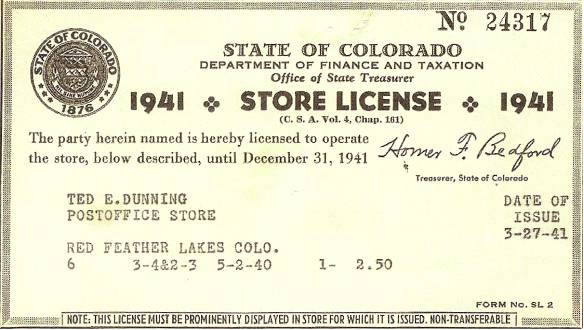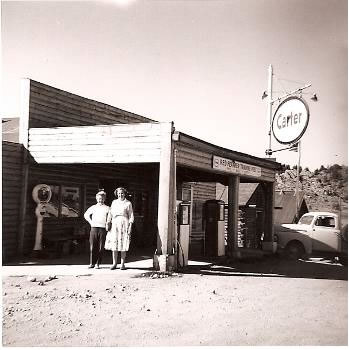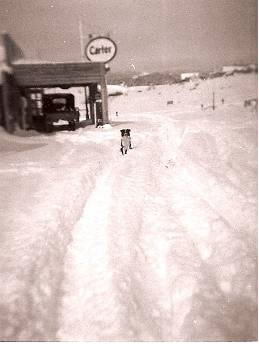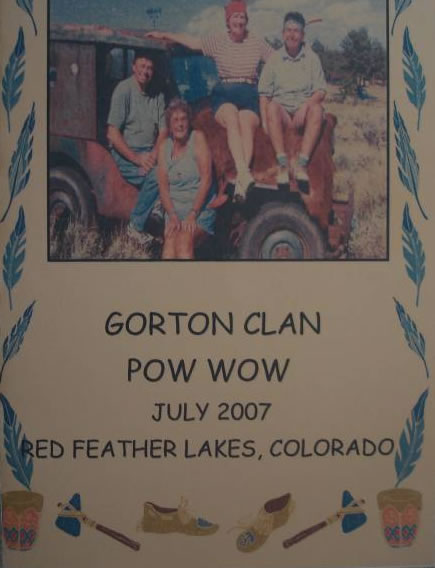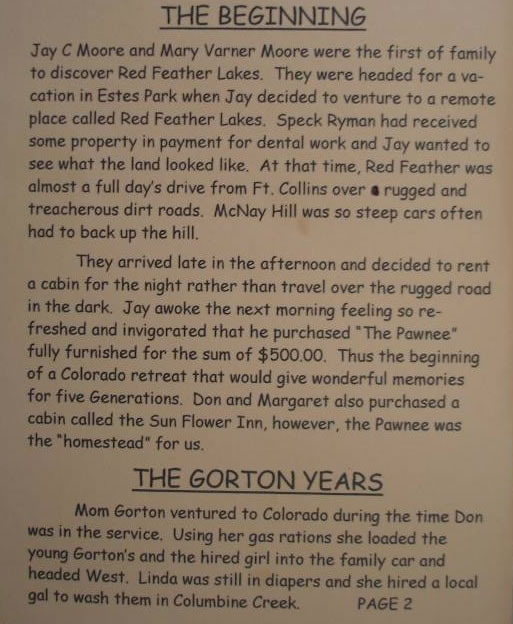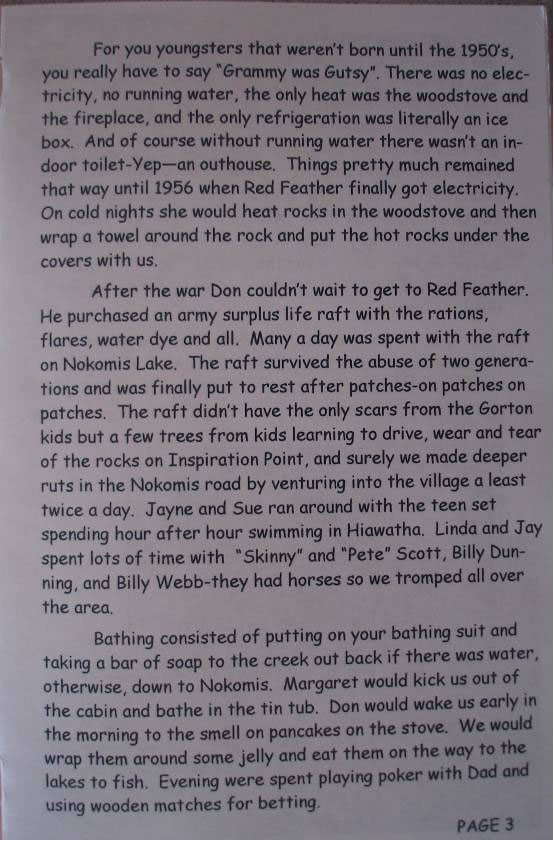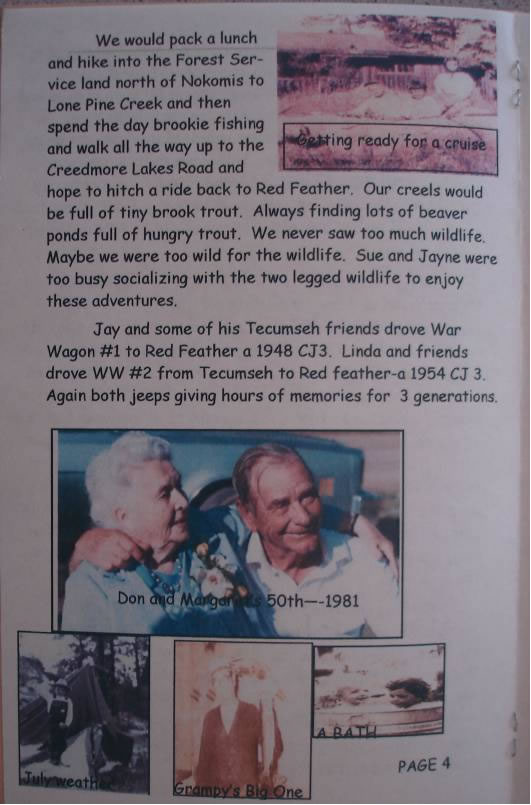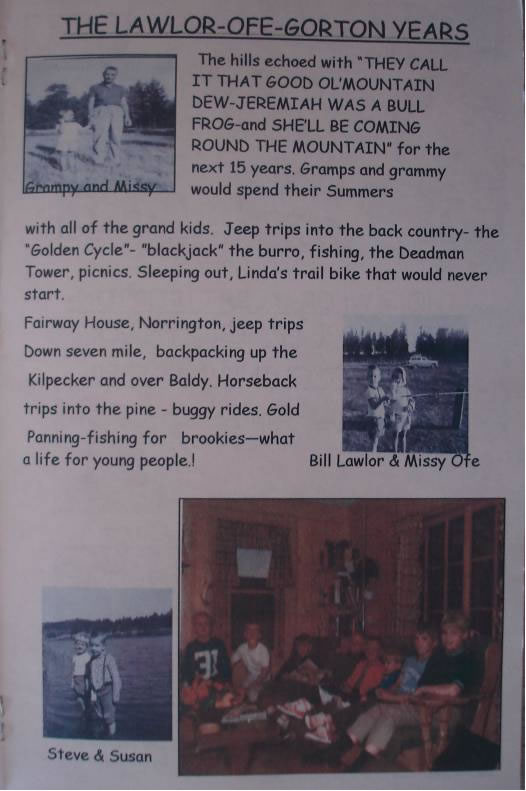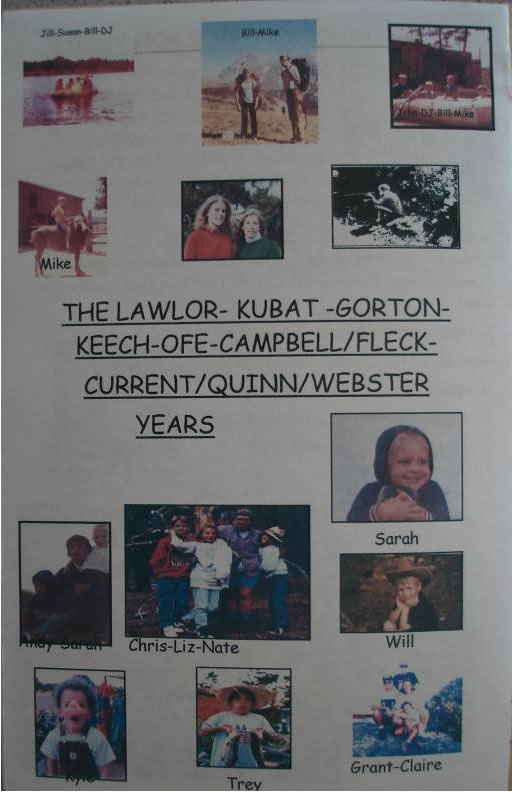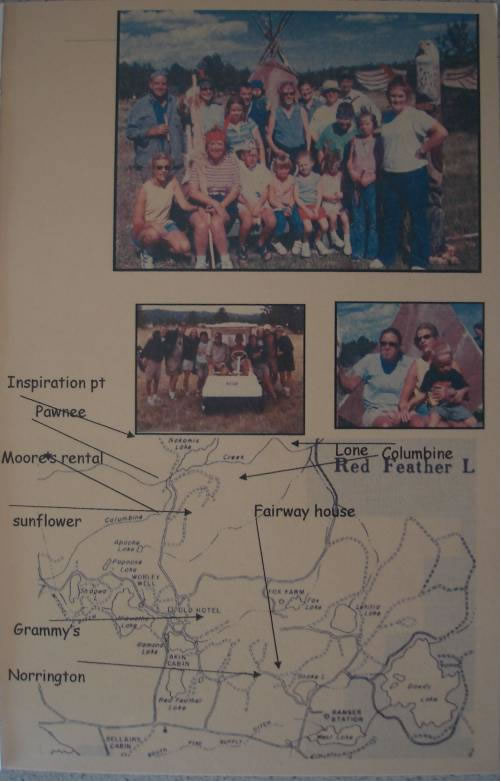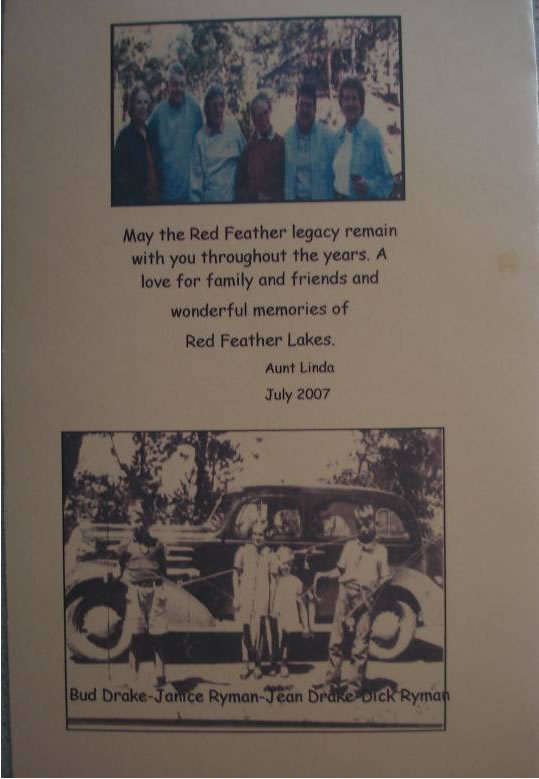Interview with Linda Gorton
July 12, 2011, at the Red Feather Lakes Fire Barn,
Red Feather Lakes, Colorado
Interview and transcription by Linda Bell
[Interview available as PDF file]
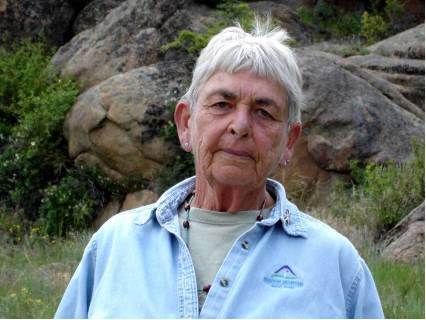
Table of Contents
- Six Generations of Family in Red Feather Lakes
- The Trading Post – Following a Dream
- Red Feather Greens
- Real Estate, yet another Portfolio
- Origins of the Red Feather Historical Society
- On the trail again – Arizona
- Family Memories of Good Times in Red Feather Lakes
- Addendum # 1 (from the family photo album)
- Addendum # 2 – History of the Red Feather Trading Post
- Addendum Number 3 – Gorton Clan Pow-Wow July 2007
Six Generations of Family in Red Feather Lakes
My family has been in Red Feather Lakes since the 1930s. My grandfather, J.C. Moore, and my grandmother … my aunt’s husband was a dentist and she received property in lieu of payment for a dental bill. (My grandparents) were on their way to Colorado, on their way to Estes Park, and my grandfather said, “Let’s go to this place called Red Feather and see what Pauline’s lot looks like.” So they drove up. It was late in the day, they spent the night, and my grandfather felt so well the next day, he bought a cabin, like that! “I feel grand – let’s go buy something.” And that’s what started it.
They purchased their first cabin for $500 – two bedrooms, completely furnished. Cabin was probably built in 1926 or `28 down near Lake Nokomis. That’s what started the family here – that was the magic that brought all the family here. Two years later, my dad bought a cabin near Apache. They had that. My sister remembers staying in that but I don’t, I was just too young. Then when my grandfather died, they sold that cabin – called the “Sunflower Inn” – and the family took over the “Pawnee” cabin. We now have six generations in Red Feather. Our hearts … everybody loves it here.
I sold my last property here last year. My brother still has a cabin, my sister still has a cabin. When my dad retired in the `60s, my mother wanted something a little more modern, so they bought a cabin on Ramona. I purchased the family cabin. Then when my friend Jody and I bought the Trading Post, we sold the original “Pawnee” at that time. Jerry Thomas owns that now. We sold that in 1980. Jerry is a carpenter and he lives here year `round. He lived here when I moved here in 1979.
The Trading Post – Following a Dream
I had worked out here summers; I ran Owen Fender’s stables and ran the golf course for three years. I think that was 1968, `69 and `70. I was enjoying spending the summers and then in 1971, I wanted something to do. I was teaching so I was spending mostly summers. I worked for Jack and Jerry Dalton `cause I’d known them for years. That next spring, a friend of mine, Marilyn Soland, and her husband bought the Trading Post from Jack and Jerry – or they were in the process of buying. So they were running it that summer. My friend Jody said, “what a dream, what a dream – wouldn’t it be fun to do something like that?” We were so envious of Marilyn and her husband buying the Trading Post.
So that fall, for some reason the sale didn’t go through, and Jack and Jerry were with it again. So I called him one day and said “Jack, what’s the story? I might be interested.” We corresponded all winter and I tried to sell my house in Vermont, couldn’t sell it, then finally in March, I said, “sorry Jack, I can’t sell my house. I don’t have the money.” And Jack said, “I’ll make you a deal you can’t refuse.”
So … about the first of May I resigned from my teaching position, packed up and moved to Red Feather Lakes with Jody. That was it.
I taught at a small college called Green Mountain College. I taught phys ed and directed the program, athletic director and department chairman – I’d been there for 15 years. I was getting a little tired of things that were happening in education. You’re losing your student enrollment, its dropping. We went from a two year to a four year; from a woman’s college to co-ed. Lots of changes. I just wasn’t happy with the situation of taking a mediocre person – wonderful, wonderful kids – but giving them a four-year education and questioning what might happen. It was the quality of the education. But the college is still going and gives master’s programs now and is doing well.
The commercial aspect was new, but I had a sense of Red Feather and it was growing. At that point Crystal Lakes was started. They were hiring all the salesmen, they had all the employees. Owen Fender had built the “High Country” and in the summers it was just wild, with salesmen entertaining people and exciting things going on. Red Feather was moving. I said, “you know, this might be kind of fun – let’s do it.” You think you know what you’re getting into, and in about a month your eyes are really wide open, and you’re saying “what am I doing?”
But I cried a lot, we both cried a lot. … You know, at the end of the summer it’s like you’re starting to draw the shades at night and there’s a little bit of light left, the business is going, the hunting season ends, but it was fun because at that time I think there were about a hundred people in Red Feather. So we would have a Christmas party at the Trading Post and just open the doors and everybody would come with … little children, and to see “grandpa.” Just to have fun and just say, “this is what it’s supposed to be like.” But at that point, you’re not making any money, you’re putting out the money, and you’re saying Red Feather is grand – we did it every year, we made it just grand.
We didn’t close for about seven years – seven days a week. Then after about seven years we started closing for one day, and the next year we were closed two days. But then that fall – it was funny – Bonnie Drake was a sorority sister of my aunt. My sister Jayne talks about being at the Drake cabin on VJ Day. So they were friends forever, so I knew Bonnie Drake forever.
* * * *
Jody and I purchased the store in the spring of `79 and we sold it, actually closed on it, on April 1 in 1994. But we said we didn’t want it to happen on April Fool’s Day, so we actually closed the day before. Patti and Dennis (McMillan) took over. Now they’ve had a lot of years. We had it for 14 years and the last 2 years we were hoping we could be fortunate enough to find the right people to buy it, because we were pretty burned out of it … (it’s) wearing on you.
It’s the hours. When we had the restaurant open, I’d be up at 4 am starting the rolls. In the winter we closed at 6 pm but in the summer you’re not going to close early. We kept open until probably 8; on Saturdays, 8 or 9 pm. But we had good help. In the summers your legs would be numb from about the knees down from about 10 o’clock in the morning until you’d go to bed.
We had … you’d have to envision it. We could seat 26 people. Where Patti has the gifts and the DVDs and then the room that goes off to the right. Now when Ted Dunning owned the store, that was their living quarters – all that back area. The kitchen area and actually where they’ve extended automotive, those were bedrooms. And then Jack Dalton put a wall, so it was just that one room, and he had the restaurant. Now we were busy enough that we took out that wall, so then it became more of an L-shaped dining room. Twenty-six was about our … sometimes we’d do the church groups, and sometimes we’d open the back when we did one or two wedding receptions. Lots of times in the fall the Chapel in the Pines people would ask us to serve a big meal, and then we’d serve 40 or 50. When we first opened we did suppers, and after two years, we forgot the suppers part, because we just couldn’t … too much. Then in 1987, we said, now if we ever sell the Trading Post – now we’ve got the wreath business – but what are we going to do to be able to stay in Red Feather at that point. You know if you’re young, if you love the winters – so we got real estate licenses and started selling.
The real estate market was so good that in about 1992 we said, we’re closing the restaurant. You don’t make that much money in the food business, and at that point we only had the restaurant open in the summers, from about the time the lakes opened for fishing until we started the wreaths, from about May to October. At that point we said, “let’s stop the restaurant.” I’d be trying to write a contract and someone would order a breakfast, and you just couldn’t do it all. Just like Patti’s saying, closing on Mondays is the best thing that happened to them. Closing the restaurant was the best thing that happened to us, because it was one less worry.
One time the (health department) came up in January, and we said, you can go through, but the restaurant’s closed for the winter. He went through and gave us a “98” and I don’t know why – because it was published in the paper. Maybe we should have been closed all the time. Because of the grill, the fire insurance was real high and we said, “are we really making any money running the restaurant?” We’re making friends, but are we really making enough to do the effort, and we said “let’s just close it down.” We did keep the dairy bar open. In fact the soft serve machine at Jack’s (at the Hilltop) – (that’s the one) Patti (McMillan) had and we inherited from Jack Dalton, which he got from Ted Blakeney when he had his gift shop and ice cream, where Lone Pine Realty is, so that machine was from the `50s. It was real temperamental, you had to be real careful, and we couldn’t let anybody that worked there run it because it would get out of balance, then it wouldn’t serve, and. … But it was a good dairy bar, and we served malts and shakes, but then we took the dining room area and just made it into gifts in the summer.
We lived over the store, and it was great. You had the view of the lake. When (ever) we’d look at the (webcam) weather, I’m looking out over our old living room. We’d look out over “sleeping bear” rock, that’s what we called it. It looked like a bear, to the south. That’s the weather (cam) on the POA now. When we were able to be upstairs and enjoy it, we really had nice views.
Fred (Foster) used to tell us all about the kinds of things they’d get up to as kids on Ramona – and they’d come out on the lake. The CCC built that road, so that road wasn’t really there (then). Fred would tell me stories about how much fun they had.
When we took over the Trading Post, (Bonnie Drake) grabbed me aside and said “I want you to take over the wreath business.” This was in 1979, that fall. So that fall I started learning the business. The next spring we bought it from her for a very meager sum and we took it over in 1980. That was really our goldmine, it wasn’t the store; that was the money maker.
It was a fall money maker. We sold all over the United States, we shipped even to Alaska. I think when we took over the wreath business it was well over 3000 individual wreaths. We probably had 15 on the trimming crew, we’d do the final trimming and shipping and we had maybe 12 to 15 weavers. They would all make the wreaths in the homes. Then about the first week in November – and for the first five years Bonnie let us use her house which was where she’d do all the trimming. There was a little storage shed right over the ditch which it was cool and dark and we’d store the wreaths there. The workers could bring them in as early as they started making them. Then we’d gather there and trim, and then we’d do the shipping from there. That would be a little hard because if we got a big snowstorm UPS had a hard time getting in. So then we put a garage at the Trading Post and started moving the operation over there. There was a huge room downstairs in the living quarters, which was just perfect – it was almost the size of this one. Then we had the garage. At that point it became a little more super-slick because UPS could just come right to the back door and we could move the boxes out to the front. After the five years, we just moved over there. We would pay for the utilities for the month we would use (the Drake cabin).
The funny story is that we had all these gals who had worked for years and at that point we still had our little restaurant open in the fall – well, I’d be committed when the trimming began, so Jody said one day, “Not only are we not going to have the restaurant open, but we’re not going to serve coffee.” So the husbands of the workers – “well, by God, if you’re not going to serve coffee, my wife isn’t going to work!” They would sit over there and drink coffee for three hours while their wives were working. So – good old Jody – and Jody had a strong streak, and she said, “that’s fine with me.” I came home and she told me, and I said, “Oh my God, who’s going to trim the wreaths for me Jody?”
They were wonderful helpers, and Lord love `em, they were so supportive. They had a good thing going because we cooked massive lunches for them and their husbands would come over and eat lunch – a three-course dinner for lunch. The next year, we lost them, we lost a lot of them. Fortunately though, we had a young Rachel Casselman and young persons whose husbands were working. We had a new influx of people. Now some people stuck with us, and one of the people that stuck with us, was Kathie Morissette. I don’t know if you ever knew her, but she trimmed for years. Melba Anderson and Emma Grauberger – and those were the main ones that stuck with us. Carol Arent was working with us and then she didn’t for a while, but then in our last five or six years, she worked for us and she was one of the best workers in the world.
We found out something. We could work with half the crew that we had before because a lot of these people were there for the social part, so they’d trim, but they did more talking then trimming. So, what could have turned into a nightmare, turned into an asset, because it was much more efficient.
Oh, Graham McPherson and Margaret McPherson were another two who stuck with us. But then we relied on some of the newer people.
After everything was done, we would make more than $10,000. We did a lot of the work. Marge and Joe Bickhaus. … Bonnie Drake was at the point where she was subbing out most of her work. Jerry Dalton did all the paperwork for her. The Bickhauses did all the wiring of pinecones. She couldn’t do most of the physical work. So we took over a lot of these chores and were able to do it. Jody could do all the paper work, I could do a lot of the heavy lugging, Jody could take care of the UPS shipping. We just consolidated. We would usually put money in a savings account every year after expenses.
We had a Forest Service permit to cut the greens. Every weaver would cut their own greens. When we first getting our permit, we had pretty much the whole forest. There were no boundaries. And in the last – let’s see, we sold the wreath business in 2004 or 2005 – the last seven or eight years we would be limited to certain areas. They’d give us five – I’ll call them zones – and you could get … I’d go in and say, I’d like a ton from this zone, a ton from this zone, up to five. I’d get permits for five ton. Now you imagine, some of the people that cut go out and cut tree limbs for their bows.
Most of us would cut greens from … well for table wreaths from 7 or 8 inches up to our giant wreath which was a 36 inch Christmas wreath – I made all of those and I would cut bows probably 18 inches. When you’re thinking about a ton of greens, if you’re looking at a piece of greenery from 7 or 8 inches up to 18 (inches), 5 ton would probably pretty much fill this room. The greens I cut myself would be an area 2 feet high and probably 20 by 20 feet. You could only cut a certain part of the tree. You can’t fell a tree and you can’t cut more than a third above the ground, which probably in the snow, might winter- kill anyway. You’re limited to what you can take from a tree. Unless you knew that I’d trimmed a tree, if you walked right past it, you might not even know it’d been cut.
It was beautiful country. We’d go all the way over to Sand Creek Pass, over in the Laramie Valley, we’d go all the way to … we cut in the Pearl Beaver area a few times, we cut up around Prairie Divide, all over in the Elkhorn, and the last few years, we’d get permits behind Dowdy. When Bonnie (had) the business, they pretty much cut over on Deadman. They didn’t have a way to store. … I don’t know if Jean told you, in the story (Jean Emond; A History of Red Feather Greens), they would take the greens down to an area just around the first cattle guard and they’d store them there until they started making the wreaths. Then they’d start bringing them in. They stored them in little crates too, and then they’d bring them down. By the time we took over, usually everyone had water so we could spray our greens when we brought them down and cool them. Originally, when Bonnie started the business in 1940, there was no way to keep them cool. We had a little easier situation because everybody had water, you could spray, you could keep your greens cool. We’d tell them to keep them out of the wind, keep them out of the sun, and keep them as cool as you can. We’d start cutting them before the first of October, and those greens, you could smell those greens and they’d last.
We cut subalpine and Douglas fir. Now, Bonnie preferred the subalpine fir. When she would hire her workers, and they’d say, “well, I live over in the Laramie River Valley and I can only get thus and such,” she’d say, “well, I really don’t want to take that because it doesn’t last as long.” But I found it lasted as long and I really liked it because it was softer. I liked the Doug, because I liked the greens better. But originally I thought, oh Bonnie’s absolutely right, maybe that’s what we need to do. Limber pine, the needles are too long.
Then of course, I had a little girl stop me – “little girl” – she has boys that are teens now. She stopped me at the fishing derby and she said, “wait, I want to show my boys … I want you to meet my boys because I keep telling them you’d give me a nickel for each pinecone I’d bring. That was when she was their age. And she said, “and I can remember, `cause you said they had to be fresh and we were just covered with pitch.” (Laughter) The little boy said, “will you give me a nickel for a pinecone?”
That’s how we got a lot of our pinecones. Rachel Casselman and another gal did a lot of our juniper for us. We’d buy it by the bag. We’d gather a lot of the pinecones, but we’d hire the kids. For years, and what Bonnie did and what we did too, we’d buy coat hangers. She would hire local people to bang the hangers into rounds. Later on – way later on in the picture – we just started buying the rings. They weren’t available until later. We used the coat hangers and then we started buying the rings, and originally for the bigger wreaths, or what we called the double wreaths, they had two rings, and then the giant rings, two rings. I started doing a lot myself. Then we’d buy the wire for the wreaths – to make the wreaths – in 25 pound bales. I would spend part of my time in the winter winding (wire) on nails. As we started advancing, we’d end up buying the wire, we’d buy the rings, and in the last probably eight years, I bought weaving machines and would give my prime weavers these – actually a machine that just clamped the wreath-making material in place with little U-shaped (stays). They made beautiful wreaths.
The wire that we wired the pinecones with come in 100 pound bales. We’d take them down to – now this is a connection Bonnie Drake had – Noffsingers in Greeley and they would cut them into lengths for me. We’d need different lengths of wires, from five inches up to eight or ten inches. And they would cut them. That’s how it worked.
We had different people … Ruth Anderson was one of our loyal people too. Ruthie would go out and collect the kinnikinnick and make little kinnikinnick bouquets. And her daughter Pat … one year they made, what, they could make up to 300 bouquets.
Carol Arent sent one to the White House – we sent them to the White House and we sent them to CBS, and we sent ours just gratis just hoping we could get some mileage out of them. We got a few letters. Carol got a letter from the White House. We sent some overseas, by air. It was pretty expensive to ship. A couple would go to air bases, or to soldiers, from their families.
You know it was fun when we were young, at home in Nebraska, and we’d just love it when our Christmas wreaths from Red Feather would come, `cause you’d open the box, and the smell … and then you’d get homesick for Red Feather. You still do and memories flood through you. No one is sending them to me in Arizona.
Real Estate, yet another Portfolio
I worked – we both worked – for Steve Koeckeritz at Lone Pine for one or two years, and then we went over to Ponderosa. We stayed with them for 15 years. The realty business was excellent. We had enough foresight to say “the next step – where do we want to go with the next step?” So we purchased the cabin in the West Hiawatha subdivision – you know that cabin – and we just bought it. We had a little extra money and we said, let’s … because we loved the view, it had a wonderful view. In fact you were there that day when Jody took the photo of the feather, and to this day, we still have that feather (photo). I show it to people and I say, “does this look like a cloud to you?” Anyway, we bought the cabin `cause we liked the view and we said let’s just use it for rental, or family, or friends. It was just a little one-bedroom and Brian and Leslie Shaneman owned it, and they had a baby and they needed something bigger and they wanted to go to Glacier View. One day Leslie said, “I want to sell that so bad I’d take about anything for it.” And I said, “well, what’s anything?” She told me and I think we settled for $31,000 or $32,000. It had a well. It was small but it had some property – when we bought it, it had three lots, but then we bought one, two, three, four more lots around it. It had a well, septic, a view, heat – it was good for year `round – so I said, at that price, let’s just do it. They bought a home in Glacier View, which at that time, prices were just starting to escalate and they got a beautiful home for about double that. When they sold again, it about doubled again, so they did well.
So we bought that, and then, we’re thinking, “OK, we’re going to sell this Trading Post within a couple of years, so let’s start thinking about an addition, and that’s when we put on that addition. So then we said, “OK, we’re going to keep the wreath business, so let’s think about a garage.” We had a garage built and a work room in it. That’s how that happened. Some people in their lives go “ready, aim, fire;” we’d go “ready, fire, aim.” Let’s get this thing loaded so we can fire again.
Jody’s sister came and lived here, and her sister brought her mother. I think that’s when we decided we might want to leave. … Her sister came here, and, like so many other people, fell in love with the place. Her sister had just gone through a divorce and was ready to leave California. She said, “I’ll be back very soon,” and she was, she bought that fall. She came here in June or July. She told Jody, look for a place, and we found her a place over off of Creedmore Road, and she went home and she came back. By the next spring she had married Wes Ball, and they were living in a different spot. Then (Jody’s) father got sick and they brought their mother here. They bought a house for her mother, a little house on the golf course, but the mother didn’t ever live there, she stayed with the sister.
Jody discovered Red Feather because a mutual friend of ours – I didn’t know Jody (yet) – but a mutual friend who taught at DU bought a place at Crystal Lakes. Jody came back one summer to visit her friend Martha, and again, she fell in love with Red Feather. That’s basically what happened. She came back from Vermont because, kind of like her sister, she’d gone through a divorce, her kids were partially grown, and she wanted a life change. She didn’t really like Vermont that much because it was too cold. She was a California girl. So that’s kinda why again it was easy to move to Red Feather, `cause we both loved Red Feather. “Let’s go for an adventure, let’s follow our rainbow and go to Red Feather and kick back in the winter and sit by the fire and not do anything and so we did.
Like I say, it was so much fun here the first year because it was warmer than Vermont, and people were so friendly and nice. People were friendly back there, but (here) it was just like one big family. Fox Acres was going strong and all these cute little kids, you know, running around, the coming in and buying your penny candy. And you’re thinking, “oh boy, I’m glad I bought that candy because those kids love it.” Just the glamour and the glitz of feeling like you’re accomplishing or maybe that you’re just “going.” Oh the funniest little thing, Clem Rivard’s granddaughter, C.J., she’d bought some bonbons and she brought Leona in one day, and she said, “See grandma, that’s the candy I like” – from the supermarket. Fun parties and fun kids. …
Like I said, we’d have the Christmas parties and Ralph Hinst – do you know Ralph? He lived up at Red Feather Ranch. Ralph would volunteer at the liquor store and help us, and his daughters, who were about 12 and 13. Every Christmas Ralph would put on the Santa Claus suit and we’d have the party and all these little kids would come in. We have some wonderful pictures of this. We’d fill the whole place – the Trading Post – up. In the summer those little girls would come up to town, in their little hats, and sit out in front and eat their ice cream. I just thought that was the most fun in the world.
Origins of the Red Feather Historical Society
You know how sometimes in the winter you finally sit back, and you say … people like Ted Dunning and Bernice George and Bonnie Drake and Owen Fender, they had wonderful stories to tell. And Bob Swan and Jo and Lafi Miller. Inge McKennan probably deserves – I’d have to give her the role of the keystone in this. Inge was the manager at Fox Acres and about every afternoon when she’d finish work, it would be about 5:00, 5:30, 6:00 o’clock, she’d stop by and we’d have a cup of coffee. We’d just talk and Inge was a good idea person. We were talking one day, and I think I just said, “you know, we do need a group.” It just – I don’t know how it burst at that point, so that she and Jody and I started talking. She knew the Stenzels, but I don’t think she knew many of the other people. Except she was a very “doing” person, outgoing, and we’d become friends, so we started talking about it. What do we need to do? There were some other people, all women of course, let’s see, there was Bobbie Michelle, Doris Hanks, Jody and myself, Inge, Judy Beatty, her husband was one of the deputies, and her friend was Al Hurst and was a widower (who) lived in Crystal Lakes. We’d all kind of get together and have coffee and talk. All of the people who had stories to tell were gone in the winter. But we said, “OK, let’s see about forming a group and we tried to set down what we needed to do, and so … we wrote letters to the people who had been here forever, like the Stenzels, and my family, and other people, and said, “would you be interested in being charter members” because we knew we needed a little money to start, and everyone who wanted to be a charter member … and we got a wonderful response. It was just great.
That summer we started our field trips; that was the summer of 1985 or `86. We got Bob Swan and Lafi and Jo (Miller), `cause they had all this contacts, and they’d give us a trip. We went to the Two Bar Seven, and all these places that wouldn’t be available for anyone to walk in and have a tour. And the Rawah Ranch and Glendevy – and like Lafi and Jo would give us a tour of the Sloan Ranch, and people were just eager for this.
I remember probably the biggest trip was the first trip to Two Bar Seven, up by the Wyoming border, and I think we had 80 people on that trip. But Crystal Lakes was getting year `round people and Red Feather was getting year `round people, plus the summer people. One would say, “oh, I’ve heard about Cherokee Park for years,” or like my family would go over there when we were kids and go to the chicken dinners that the Fords had. People would say “Yeah, I went there as a kid, I want to go there again” – it just snowballed, that’s how it happened, it snowballed. So good old Inge, again, because she was kind of an organizer, we said “maybe we should have a special event.” We talked about a winter carnival, then somebody said – I don’t know who it was – “well, they do the Christmas tree cut every year, let’s do an event, `cause they’re coming up for their Christmas tree, let’s see if we can get people to stop.” And that’s how the “Greening” started. That was December `86.
Historical Society started the (Fine Arts Festival over Memorial Day weekend) and originally we said let’s … each year can be a different money making project for different groups. It was supposed to be the school, the library and the Historical Society. I don’t know if the Fire Department was part of it – I don’t think they were because they had “Fire Days.” Then something happened three or four years into it and we weren’t happy with what the school wanted to do with the money. They wanted to buy this … playground equipment I think it was … (sotto voce) someone said “I don’t think they should get that playground equipment.” It was about that time that we were kind of moving out of it. Originally the concept was that the library would get it, then rotate it, and then hopefully, the different groups will be in charge. And again, I think we started getting into the thing that it was the same old people, same old people do this and the same old people do that. We need some same old “new” people to do it. It kind of wore a little thin.
I would say the majority of our people (involved in the Historical Society) at that time were from Crystal Lakes because so many of the Red Feather people would leave in the winter. But we had a lot of year `round people in Crystal Lakes that had been educators, or had been in professional positions and had retired, they wanted to donate their time and energy. We just had a great time. Super thing.
One time (at Christmas) the newsman from … Matt, Matt Maraka … he used to be on one of the TV channels and he came up and we had more fun. This gal named Judy – and Ross – I can’t remember their last names, from Crystal Lakes, or rather Beaver Meadows, they ran the stables and they got a horse-drawn carriage. We gave Matt Maraka a carriage ride over to the “High Country” (restaurant), we had a cocktail party for him. But before that we got all the little elementary kids that wanted to, to come to the Red Feather Café and they sang Christmas carols with Matt. And we were on TV the next day!
Good old Inge – Inge had an imagination – she was the one that took over this “gnome” concept. Did you ever see the little Red Feather gnomes? I think you still had some in your shed. This had nothing to do with “Elf Lane.” We said, “let’s have a little contest and make it a contest for Christmas decorations we can sell at the Greening of Red Feather.” So Grace Zack, who was a retired schoolteacher, and she and Bob lived in Crystal, came up with the winning thing, and it was the “Red Feather Gnome.” She took a little pinecone from a lodgepole, and that was the gnome’s face, cute as could be; made a little gnome’s hat, put a little green gown on it and a red felt hat, pipe cleaner things for legs, and put a little pipe cleaner to hold it on the Christmas tree, and that was the “Red Feather Gnome.”
So Inge gets this idea, that we have at the “Greening of Red Feather,” a Princess Red Feather on a horse riding into the village with the little gnomes behind her, who were the little elementary school children who wanted to do it. It was as cute as could be. That was in our first or second year. Pat (Clemens) would have something (in the Red Feather Historical Society files) about it. And so the horse came from the Ross Ranch and his name was “Alpo.” Judy Beatty – was it Judy’s? No, not Judy’s, it was her sister-in-law’s, Ron and … Beatty was his last name but I can’t think of his wife’s name – their daughter had been “Princess Red Feather” or something, but she was a real pretty girl so she was going to be “Princess Red Feather.” Inge and us cut out these little felt things for the kids and they got on the horse up at Ponderosa (now Mountain Craft Gallery) and (led the) gnomes down the hill. Inge wrote the story that Princess Red Feather was out in the woods and she fell and hurt her ankle, but the little gnomes saved her and put her on the horse and got her back … we had this little pageant, down the hill and it was cute as could be, but we only did it a couple of years.
The worse part about … was Leslie Clark brought, or rather Leslie Shaneman was her married name, would bring Alpo up for us, but I had to take Alpo home. I hadn’t been on a horse in ten years. The horse knew more than I did at that point because he knew the shortcut that would get us to the ranch much sooner, but I was going along on the road. I’m thinkin’ I’m scared to death because these Christmas trees are buzzing past on the cars, the horse is going to get scared and I’m going to be mashed up on the pavement. Well, it didn’t bother the horse at all. (He came from) the Ross Ranch, which was where Sugarbabe lived, Ron’s folks. But you see I thought we had to go all the way to Parvin to get in, and the horse kept trying to cut across. There was a gate, which was closed, but the horse knew there was a gate. I said, “Alpo!” We finally got there. Alpo was fine and I haven’t been on a horse since then.
It was great, and we have some good memories. It was lots of fun. Inge had the imagination, Inge had the drive.
In 1999 we were getting tired of the winters and the wind, especially when we worked, when Ponderosa (Realty) was on the hill (now Mountain Crafts Gallery). The wind on that hill would be so bad that in the three or four years we were selling up there, the windshields on the vehicles would be broken from the wind, from gravel hitting them. That’s how bad the wind was at times, the wind chill. And then Lucille, of course, moved her office down – but we were tired of the winters. There was a young fellow that worked in the Ponderosa office and told us how he had been stationed at Fort Huachuca in Arizona and how on January 1, the temperature had been 80 degrees. And I said, “show me where that is on the map.”
So we ventured again – this “ready, fire, aim” again, whichever the way you do it – we said, in April let’s go look at possibly buying something so we can go down three or four months of the year. So we did – we went down, and explored, and found a place. We could get away because the wreaths were seasonal. And we were still selling at Ponderosa, but we said it’s time to start thinking about a little retirement. So we bought a place. The first year we spent three months, then four months, then when we were spending more time, we said, wouldn’t it be better … we’re not being fair to our real estate people, let’s sell the wreath business and let’s just retire and not worry about things. Dick and Joan Rosecrans had said they wanted to buy the wreath business. And also, the fellow who started the Gallery had offered to buy the business, Russ and Dorothy (Wakefield) – anyway, he wanted to buy it. But Dick and Joan and their boys and their wives had been working for us in the wreaths for five or six years by that time. We felt it would be better placed there, because Russ didn’t know anything about the mechanics. He knew about the marketing, and probably could have marketed, but he would be hard put to find workers with the experience, so we sold it to Dick and Joan and their kids. So that’s how we got out of that.
When we were finishing up, we had lost some accounts because people … see Bonnie Drake had these accounts, and some of the accounts we had inherited from Bonnie, she had had since the early `40s. They were wholesale to church groups. Like this Trinity Church in Lincoln (Nebraska), they had dealt with Bonnie for years, and they dealt with us, and they knew us as the “wreath ladies of Red Feather” – that’s what they called us. Our accounts were all over the country, but over the years we had lost some. Like one year, a group from Sydney, Nebraska, came out and they traveled on horrible roads and they said, “we can’t do it anymore; we’re too old.” In fact one year we had an account at Cabela’s – we did about a $1000 account with Cabela’s for the wreaths. They had us back there and we went over there and did it all.
So many places now –our big commercial (orders), what we call our “giant wreaths” – fire codes were saying they couldn’t have live greens. So this made a big difference too. But we still had a strong business and I think Dick and Joan had a strong business, but those were wonderful years and it’s something you won’t see any more `cause just of changing times.
So, that’s the story of the wreaths, and that’s the story of the store, and that’s the story of the Greening.
We sold the house on Creedmore Lakes Road – we sold that in probably 2008, I’d have to think. I think it was 2008 because we rented it a couple of times when we were gone for the winter, then we’d come back for the summer. But we were staying here less and less.
In Arizona, we first had a two-bedroom condo, and then a couple of years after we’d been there, we moved up to a three-bedroom, because we knew we wanted to spend more time there. We both worked at the golf course. We worked there when it was a thriving thing, then we just ended up being full-time volunteers for the course, now. I still am. I think we’ve been down there at least six years, full time. We’ve seen a lot of changes over the years. We’re so lucky Patti and Dennis (McMillan) are at the store, just `cause to see what’s happened to the other places. Of course, that … we really didn’t make that much money off the store when we had it, but this is our retirement because we’re carrying them and it’s been a good income. That’s the story of our lives – carrying somebody – but we’ve been pretty lucky. That’s our retirement.
(Jody Dahlstrom passed away after a short illness in October, 2010.)
Family Memories of Good Times in Red Feather Lakes
As long as my family is here I’ll return. They love it here – as I’ve said, the sixth generation are still toddlers, but the fifth generation have the same love my brother and sisters have. My nephew came up from Texas last week and I haven’t seen him for years. We sat around and asked, “what’s your best memory?” and the years I ran the stables and golf course for Owen Fender and those kids were all early teens, and they. … We had Danny the pony, and he had a little wagon, and they’d ride him and Blackjack the burrow. Their memories are of the stables, their memories are of singing around the campfire, the fishing, the picnics, the hiking, and the same memories.
We had this life raft – when my dad came back from World War II and somehow he had this life raft and for two generations that life raft … we’d patch it every year but that generation, and we have photos of like my brother, my sisters and myself in the life raft, then the next generation, that same age group, on the life raft.
The life raft had the food and the dye – here’s this little can of dye that if you’re stranded in the ocean you put the dye, so the planes could fine you. My brother and I put some of that dye in the lake, Lake Nokomis. It didn’t cover the whole lake, it just covered a small area for a couple of days! We were just playing like we were stranded, we didn’t think we were doing anything wrong.
One of my nieces was in a bad accident on the road – she’s great. She was probably 15 or 16, then she’s getting married this fall, she’s 32 now. She works at Fox Acres for the summers. She came up here – my grand-niece, not my niece – and she worked at Fox Acres and then went on to work at Troone in Phoenix for years. After she graduated from college, she came back and worked at Fox Acres. Good contacts.
The stables were over at the High Country, behind the High Country. The barn, the shed’s still there for the horses. Owen bought Trout Lodge, then he bought that land where the restaurant is from Ralph Swanson, and he actually bought it because he bought one of the cabins, then he bought another cabin, and then my dad and Ted Dunning and Harold Fite and Will Engles and all, kind of rebuilt the golf course. The nine holes were just on one part of it, and when we had the stables … Owen thinks, OK, I need the restaurant, I need the stables, and so the back part, which would be behind the Sportsman and the Super was just pasture for the horses. Then when Norm Stitt and his group established the High Country Estates, they changed the layout of the golf course and changed. … That was part of the original golf course. There was also a golf course over where I lived on Creedmore too. Oh yeah, if you look at the Red Feather history book, there’s a photo of Ted Dunning on that golf course. You can still find some of the greens there. It crossed Creedmore Road, one, two, three times. And when we were kids, they’d have rodeos out there too. I remember as a kid, we’d go there. I remember somebody broke an arm one time and I thought, where’s a doctor … well, one of the kid’s dad. And this Bobby Webb, he and his dad lived over where Red Feather Ranch is, and Bobby would come up about every day and horse around with us kids. He was a neat kid. He ended up owning the mercantile down in Masonville. He was a friend as a kid.
I have to tell you this one funny story.
In the late fall, sometime in the early `80s, and this was when there was a bar where Lone Pine Realty is (now). It might have been a Saturday night `cause usually there wasn’t too much action until Saturday night. We had just closed the store, and just closed the liquor store, and someone’s out there pounding on the door. We opened up and said, “what’s wrong,” and the person said, “someone just robbed your liquor store!” So I went down there, and the door was closed, and I looked around, and I said, “are you sure?”
“I saw this guy running out with … his arms,” and sure enough, they’d broken the window and gone in the window, and then gone out the front door. The only money left in the cash drawer were coins. So the fellow at the bar saw him leave, and I said “where’d he go,” and he said, “well, they went running up over towards Ramona.” Everything he had, he had in his arms – he wasn’t very smart. So we called the sheriff and the sheriff finally gets there – it had to be in the early spring, it wasn’t in the fall, because Jody’s daughter was working for us at the time, she’d come out for the summer. So the sheriff comes, and he’s lookin’ for traces of stuff, and they’re doing all this, hemin’ and hawin’ around and so Dale Bochan owned what’s now the hardware store – a grocery store, he was an assistant or one of the volunteer deputies, and he says, “I don’t know what’s goin’ on `cause my daughter looks out that window every night and why she didn’t see it, I don’t know.” And he’s gone.
At two o’clock in the morning we get a call; “well, we’ve caught your. …” He was somebody stayin’, renting full time down in Emma’s trailer park, and the way they found him, it had been raining and his tennis shoes were outdoors and the tennis shoes were full of coins. They knock on the door and he answers, and he was drunk, and it was fortunate because the deputy didn’t have his handcuff, so he just said, “If you don’t fight me, come along and I won’t cuff `ya.” And they took him down.
They were searching the area and they saw him running down the road on foot, so they were just searchin’ and they just saw these wet tennis shoes outside this little cabin…. He ended up in jail, but I don’t know where.
There was one real scary time when some guy who was probably a mental issue, and he came into town and he first went up to Hilltop and threatened there. Meanwhile, this little Melva Anderson, he shocked her on the road out here and did some weird thing, so she came in and said, “there’s a crazy man in town. Here, he’s comin’ down, lock your doors.” And he came across and went into the café, and he was carrying a crowbar. Meanwhile, Ron Beatty who was deputy sheriff pulled into town, stopped his car and drew his pistol and went into the bar and got the guy. The guy had a truck and he left it parked at the Hilltop and that night somebody in Red Feather moved the truck and started it on fire – burned the truck. But somebody said this guy had a girl. …
***
Linda Gorton Addendum Number 1
From the Family Photo Album
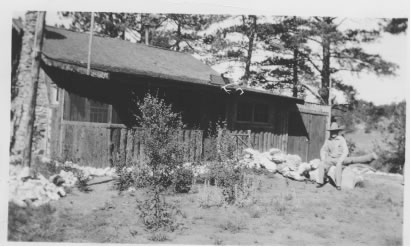
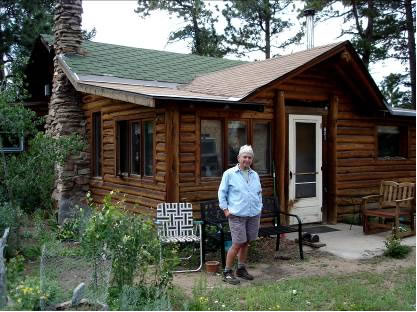
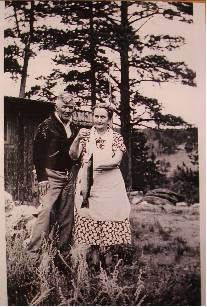
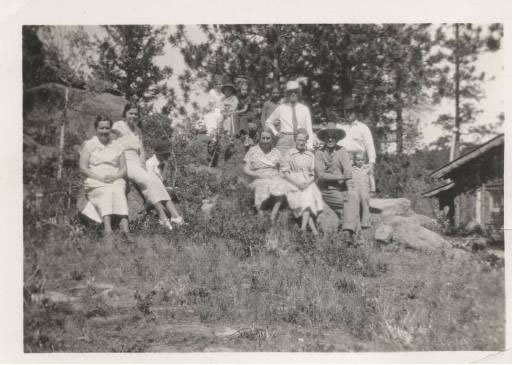
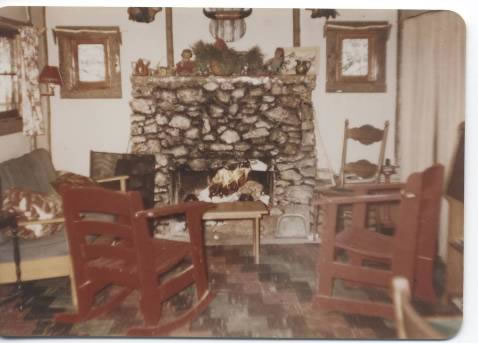
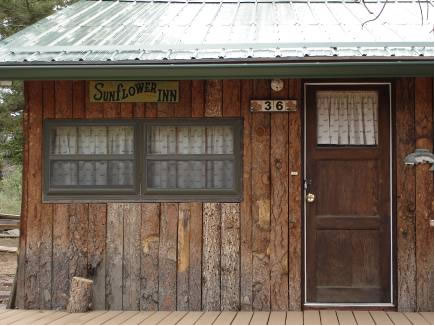
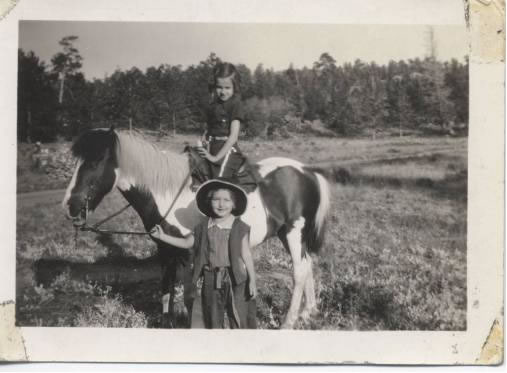
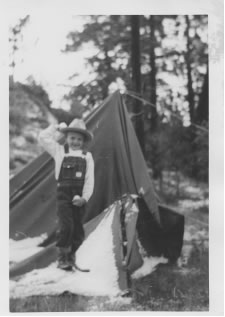
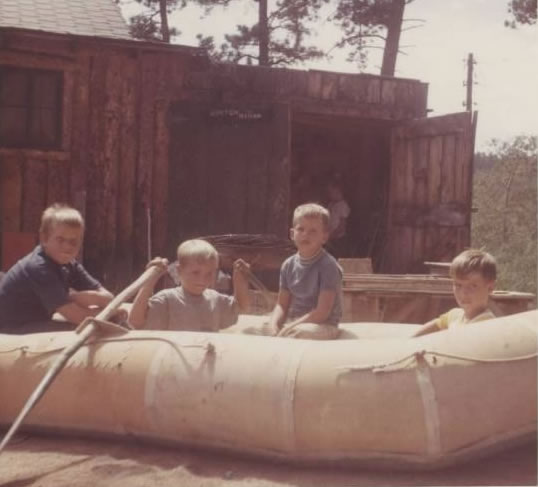
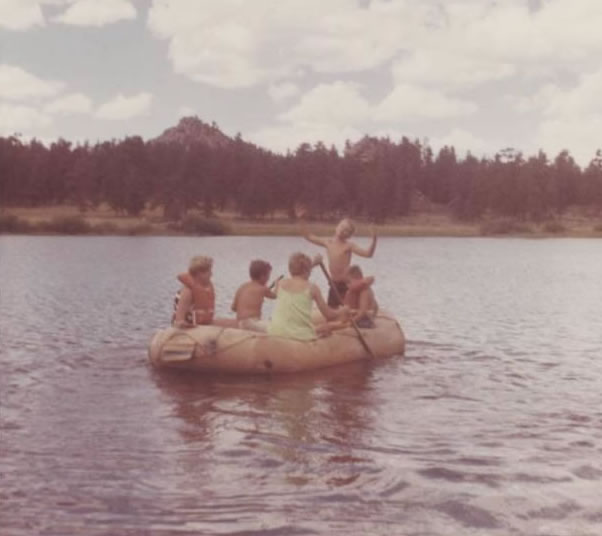
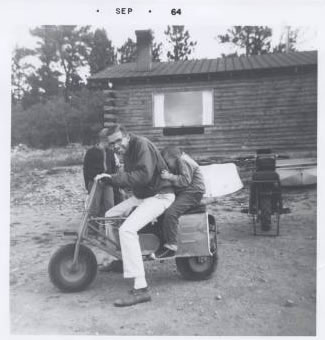
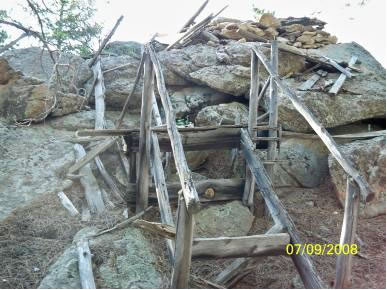
***
Linda Gorton Addendum Number 2
History of the Red Feather Trading Post by
Dennis and Patti McMillan
What is some of the history of Red Feather Trading Post?**
The Red Feather Trading Post was established Circa 1924 and operated by Goldie Hastings.
Ted and Mildred Dunnings owned and operated it in the 1940’s.
Dick and Laura Lesher owned and operated it in the early 50’s.
1952 Electric Power was installed in the Trading Post.
Buzz and Phylis Sandburg owned and operated it in the mid 50’s. Phylis was Dick and Laura’s daughter.
Jack and Jerry Dalton purchased the Trading Post in 1956. Jerry was Buzz and Phylis’ daughter.
Circa 1969 Living quarters were added to south side of Trading Post. The previous living quarters were turn into a Restaurant.
Linda Gorton and Jody Dahlstrom purchased the Trading Post in 1979.
Circa 1985 Restaurant was closed.
Dennis and Patti McMillan purchased the Trading Post in 1994.
1994 Added Video Store.
1995 Incorporated space that was restaurant into the store.
2000 Installed walk in cooler in middle of store.
2003 Built clearspan building over Trading Post and Liquor Store giving the building its present day look.
** Used by permission, from the Red Feather Trading Post website: redfeathertradingpostco.com
***
Linda Gorton Addendum Number 3
Gorton Clan Pow-Wow July 2007
Red Feather Lakes, Colorado
